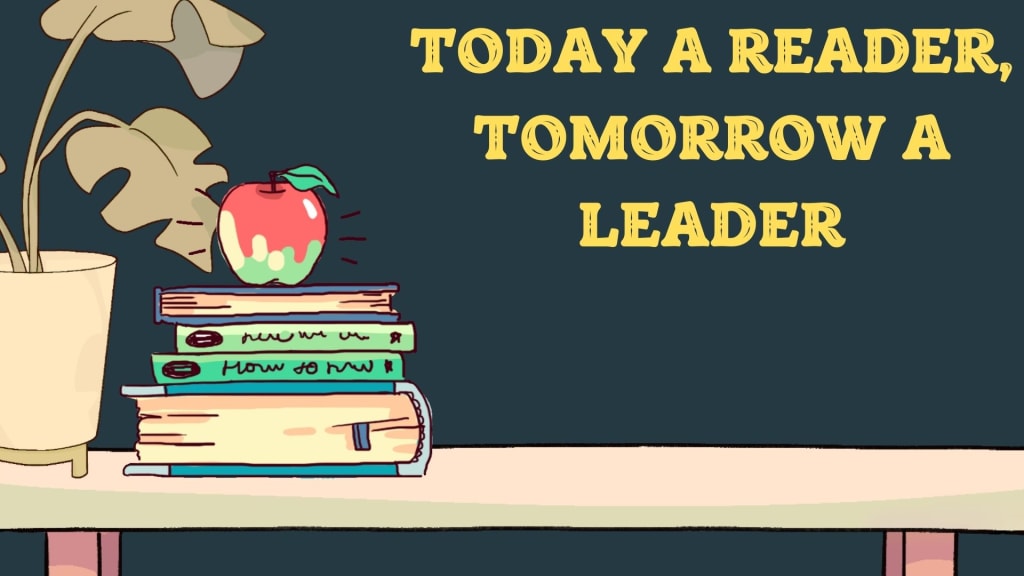Today a Reader Tomorrow a Leader
Effective book reading is an important reading skill for a student's success. Almost all classes make you read them.

Reading textbooks is weird. That's fine. Granted, we all need to read them. But even you bookworms (the kinds of people who devour Twilight books in a week, or Harry Potter, or Hunger Games books) know that textbooks are weird.
Think about it. Textbooks are the only books you read today with pictures on almost every page. In fact, if you are forced to read a book without pictures, you are in real trouble. Those books are very difficult. However, understanding how to read a book is important.
The goal of a textbook is simple: to inform and teach.
The goal of Harry Potter's books is very different. Novels tell stories. Textbooks convey ideas through the definitions of information. Because of this, you need a different reading strategy. Follow these four simple steps to get in your way.
Don’t read front to back
Reading a book back to front ensures that you will not waste time. I know it is a challenge not to read a book forward, but do not. Mysterious novels stink when you read the background first, as do some delightfully good films. If you read the last page of the Sherlock Holmes novel before you read the story, it will be a joke. If you know Bruce Willis is dead, don't look at Sixth Sense.
But textbooks do not usually create suspicious twists in the end. I promise you. I learned a lot. They do not even know the amazing conclusions. "Then, Abraham Lincoln saved the bullet!" Of course, that will never be in a textbook.
Want to try this strategy? Try to read the chapters of your books this way.
Go to the questions at the end first. Read it, respond with all you might, and start your real learning strategies.
Next, read the final summary of the chapter. This will give you a general background to the main ideas in the chapter.
Third, look at the headings and paragraphs of the chapter.
Fourth, read the introduction to the chapter.
From that point on, you can then use the chapter from front to back. By using this out-of-order strategy, you are not focusing on chronology, but rather on linking the ideas found in the chapter together. This is more important than learning things in chronological order.
Read for Big Ideas
Textbooks are very accurate. You, while being careful, will not be able to find all the details in the chapter. You want to emphasis on what is most significant. See our post on filters for more information on this.
Textbooks are good because they explain those great thoughts in context, but make sure you don't get lost in a few minutes. Read the Great Ideas first, and before that, you will be able to explore the mountain of available information. One of the leading textbook publisher in India, Pragati Prakashan have their books in various domains and genres.
In textbooks, "big ideas" are easy to spot because they are often printed in bold or under section headings. Look for the complete idea of a summary sentence and call on each paragraph; you will have identified the main ideas.
Read for Key Details
Big ideas need support. Other than that, they are just ideas. After you identify each main idea, write down supporting details that complement and help the main idea make sense.
Although this look is different for each topic, it should be easy to choose. Important people, places, and events often become important details in history books. Program rules are important information that is often found in programme manuals. In languages, words are part of the text. Look at your notes by comparing them to the questions at the end of the chapter. If they show the same key details, you know you are barking up the right tree
Read the book once and notes multiple times
In theory, you should never read a chapter more than once. If you read well and took notes while reading, you have a record of the thoughts that were spoken. There are some textbook publishers in India like Pragati Prakashan that design their books in such a way that reader can easily understand topics in first read.
Granted, it takes time to adapt to this approach. Do not be discouraged if you have to correct something before you can read the chapter once.
But if you do work now to get used to reading a book effectively, consider the time you will spend later. We promise you will see the benefits soon. For those of you who are already using this kind of book-reading strategy, congratulations on making a name for yourself without losing your public life. Well done.
About the Creator
Vishal Kumar
My name is Vishal Kumar, Basically, My highest qualification is MBA I have 4 Years of experience in Business Development. Currently, I am working in the Ebooks ELibrary company as a Business Development Manager for 1 year.






Comments
There are no comments for this story
Be the first to respond and start the conversation.